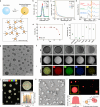Polyphenol-stabilized coacervates for enzyme-triggered drug delivery
- PMID: 39181884
- PMCID: PMC11344779
- DOI: 10.1038/s41467-024-51218-8
Polyphenol-stabilized coacervates for enzyme-triggered drug delivery
Abstract
Stability issues in membrane-free coacervates have been addressed with coating strategies, but these approaches often compromise the permeability of the coacervate. Here we report a facile approach to maintain both stability and permeability using tannic acid and then demonstrate the value of this approach in enzyme-triggered drug release. First, we develop size-tunable coacervates via self-assembly of heparin glycosaminoglycan with tyrosine and arginine-based peptides. A thrombin-recognition site within the peptide building block results in heparin release upon thrombin proteolysis. Notably, polyphenols are integrated within the nano-coacervates to improve stability in biofluids. Phenolic crosslinking at the liquid-liquid interface enables nano-coacervates to maintain exceptional structural integrity across various environments. We discover a pivotal polyphenol threshold for preserving enzymatic activity alongside enhanced stability. The disassembly rate of the nano-coacervates increases as a function of thrombin activity, thus preventing a coagulation cascade. This polyphenol-based approach not only improves stability but also opens the way for applications in biomedicine, protease sensing, and bio-responsive drug delivery.
© 2024. The Author(s).
Conflict of interest statement
The authors declare no competing interests
Figures




References
-
- Yewdall, N. A., André, A. A., Lu, T. & Spruijt, E. Coacervates as models of membraneless organelles. Curr. Opin. Colloid Interface Sci.52, 101416 (2021).10.1016/j.cocis.2020.101416 - DOI
MeSH terms
Substances
Grants and funding
- R21 GM153048/GM/NIGMS NIH HHS/United States
- # 2242375/National Science Foundation (NSF)
- 1R21GM153048-01/U.S. Department of Health & Human Services | NIH | National Institute of General Medical Sciences (NIGMS)
- DP2 HL137187/HL/NHLBI NIH HHS/United States
- ECCS-2025752/National Science Foundation (NSF)

